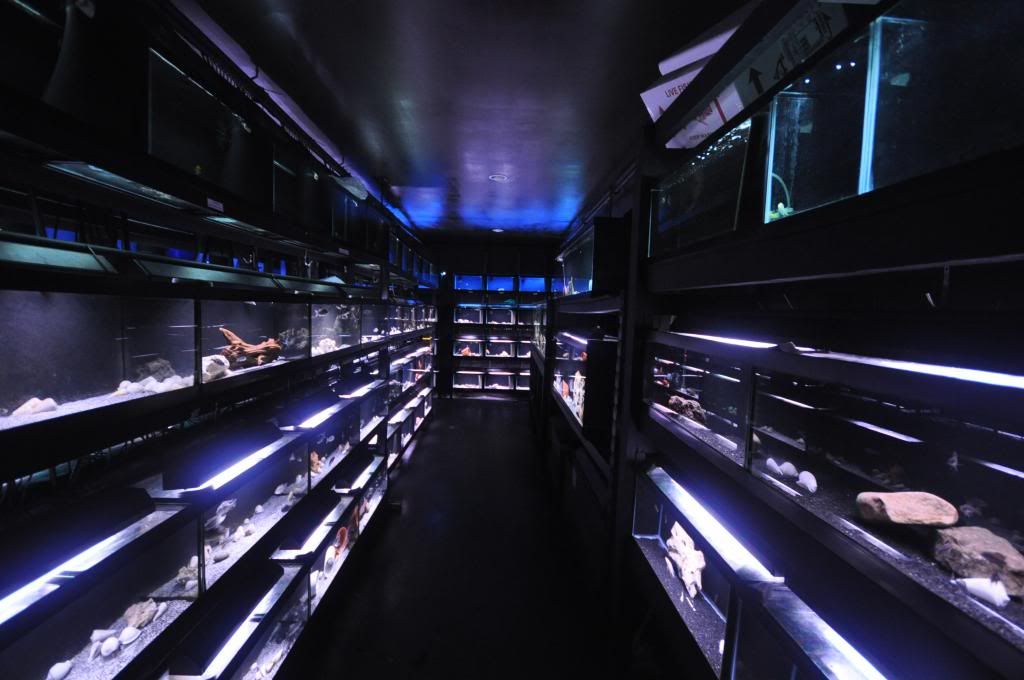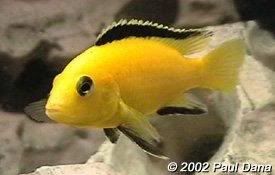Post by sirknight on Apr 5, 2009 14:54:42 GMT -6
Nutrition - Calvus and Compressiceps will eat most flake foods such as NLS. There are many foods that they will benefit from. I feed NLS substitute that I got from Jon at least once a day and usually frozen brine shrimp. I also feed them 3 or four times a week with blood worms. I usually feed their fry Microworms for them for the first month or so then newly hatched brine shrimp.
Sexing - Sexing is extremely difficult to do on juvenile fish. Your best bet is to buy at least 6 to 12 juveniles and sell or give away extra males. Sexually mature males can become very aggressive toward each other. When buying juvenile fish from the same batch, try to get the largest one and several smaller ones . This should produce at least one male and hopefully a lot of females.
Adult calvus tend to have characteristics that can give a good hint as to the sex. Males get larger and usually have a higher forehead whereas the female stays a little more "bullet" shaped. To make absolutely sure you can vent them using a magnifying glass and a flash light. This is better to do with adults. What you are comparing is the size of the genital papilla between the anus and the anal fin. The females will be larger than the male. If you have the same sexes the females genital papilla will be larger than the anus, the males will be about the same size.
Water - In my opinion this is a very important. I prefer to try to keep my water as close to the lake chemistry as possible. I do water partials of about 25% weekly and tanks full of fry I do 25% twice weekly. Altolamps. do not like big water changes , sudden changes in PH or temperature but they do like clean water. I like to keep a PH of around 8.6, temperature at around 77 degrees, and Carbonate hardness (KH) around 220 ppm. They are not tolerant to excessive levels of nitrate, therefore their tank should be kept free of wastes by good filtration and vacuuming during water changes. It is very easy to shock them so be patient when you are doing something to the water.
Breeding - In the wild both calvus and comps . spawn using shells or tight openings in rockwork. The female will get out of reach of the male at this time to avoid injury. In an aquarium it is also important to remember that the female needs refuge at breeding time. I use shells for my breeding set ups, which should be large enough for the female but too small for the male to enter. These can easily be taken out of water to retrieve your fry. Altolamps. can be bred in pairs or in harems. I have had more success with harems with 1 male and around 2 or 3 females. I recommend a tank at least 29 gallons with hiding places for every female. I generally try to extract the fry before they leave the shell. This can be tricky since the length of time from wigglers to free swimmers can be between 10 and 14 days. It is usually best to wait until the yolk sack is gone before removing them. If they leave the shell into the tank they will most likely become food. I have seen the mother eating them once they are on there own.
Get ready for a long time waiting for them to mature. It takes a lot of hard work rearing calvus. It is can take 6 months to get them to a 1 inch size. It is my experience that males will be larger even at this age. When rearing fry it is very important to weed out the larger ones that could possibly eat the smaller ones, or bully them out of food. This takes at least 3 tanks or a large tank divided into different sections.
I hope this helps explain how I do it and what to except.
Sexing - Sexing is extremely difficult to do on juvenile fish. Your best bet is to buy at least 6 to 12 juveniles and sell or give away extra males. Sexually mature males can become very aggressive toward each other. When buying juvenile fish from the same batch, try to get the largest one and several smaller ones . This should produce at least one male and hopefully a lot of females.
Adult calvus tend to have characteristics that can give a good hint as to the sex. Males get larger and usually have a higher forehead whereas the female stays a little more "bullet" shaped. To make absolutely sure you can vent them using a magnifying glass and a flash light. This is better to do with adults. What you are comparing is the size of the genital papilla between the anus and the anal fin. The females will be larger than the male. If you have the same sexes the females genital papilla will be larger than the anus, the males will be about the same size.
Water - In my opinion this is a very important. I prefer to try to keep my water as close to the lake chemistry as possible. I do water partials of about 25% weekly and tanks full of fry I do 25% twice weekly. Altolamps. do not like big water changes , sudden changes in PH or temperature but they do like clean water. I like to keep a PH of around 8.6, temperature at around 77 degrees, and Carbonate hardness (KH) around 220 ppm. They are not tolerant to excessive levels of nitrate, therefore their tank should be kept free of wastes by good filtration and vacuuming during water changes. It is very easy to shock them so be patient when you are doing something to the water.
Breeding - In the wild both calvus and comps . spawn using shells or tight openings in rockwork. The female will get out of reach of the male at this time to avoid injury. In an aquarium it is also important to remember that the female needs refuge at breeding time. I use shells for my breeding set ups, which should be large enough for the female but too small for the male to enter. These can easily be taken out of water to retrieve your fry. Altolamps. can be bred in pairs or in harems. I have had more success with harems with 1 male and around 2 or 3 females. I recommend a tank at least 29 gallons with hiding places for every female. I generally try to extract the fry before they leave the shell. This can be tricky since the length of time from wigglers to free swimmers can be between 10 and 14 days. It is usually best to wait until the yolk sack is gone before removing them. If they leave the shell into the tank they will most likely become food. I have seen the mother eating them once they are on there own.
Get ready for a long time waiting for them to mature. It takes a lot of hard work rearing calvus. It is can take 6 months to get them to a 1 inch size. It is my experience that males will be larger even at this age. When rearing fry it is very important to weed out the larger ones that could possibly eat the smaller ones, or bully them out of food. This takes at least 3 tanks or a large tank divided into different sections.
I hope this helps explain how I do it and what to except.





